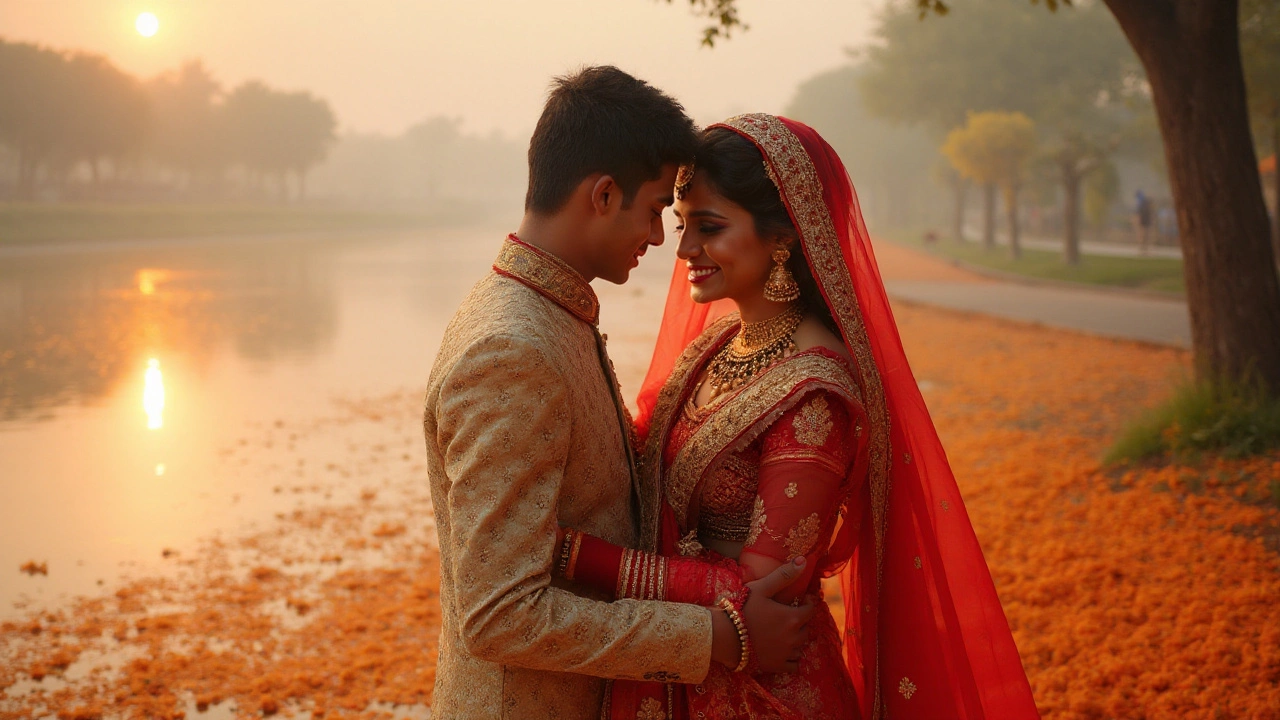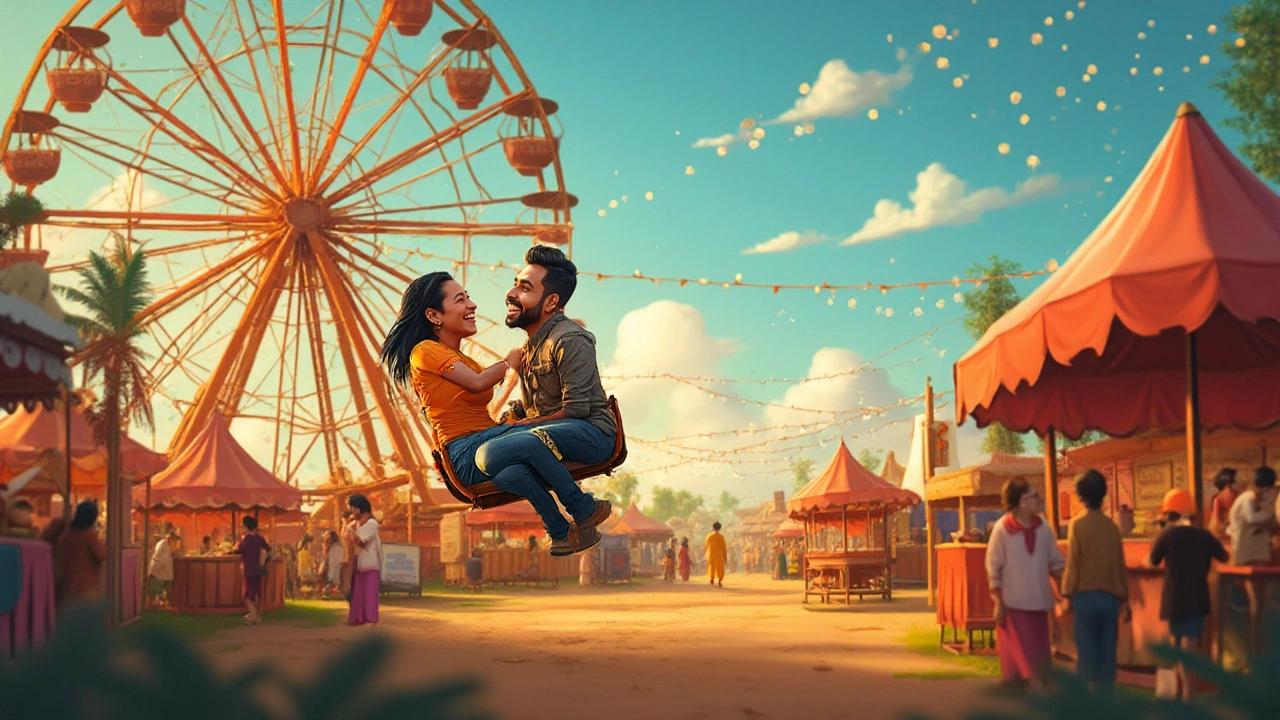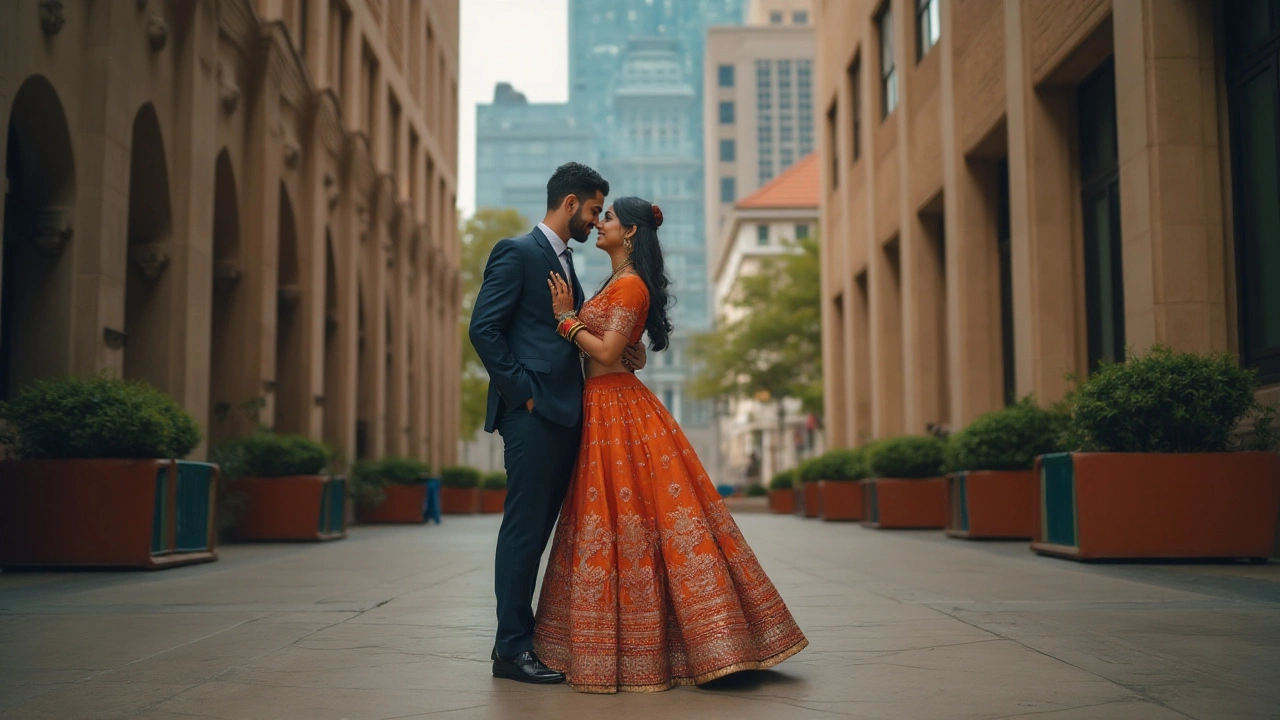Mastering the 60-20-20 Rule: A Guide for Pre-Wedding Photoshoots
 Jan, 29 2025
Jan, 29 2025
Pre-wedding photoshoots have become an integral part of modern wedding preparations. These sessions offer a unique opportunity for couples to capture their love story in a personal and creative way. But without proper planning, it can easily become overwhelming. This is where the 60-20-20 rule can be a game-changer.
This rule isn't just about numbers; it’s about creating harmony between time, budget, and photoshoot elements to paint your love story with brilliance and joy. It enables couples to navigate through countless pre-photoshoot decisions with clarity and confidence. By emphasizing the importance of each element, couples can focus not just on aesthetics but on truly memorable experiences.
- Understanding the 60-20-20 Rule
- Choosing the Right Locations
- Defining Style and Themes
- Planning for Time and Budget
- Capturing Genuine Moments
Understanding the 60-20-20 Rule
In the world of wedding photoshoot tips, the 60-20-20 rule stands tall, offering a balanced approach that many couples find indispensable. Let’s begin by dissecting this rule to understand its components. The 60 in this equation refers to the overall time and effort dedicated to planning. It's about ensuring that the groundwork is laid out meticulously, leaving no stone unturned. This substantial portion emphasizes not just on scheduling, but also on the finer details, such as coordinating with photographers, selecting dates, and planning every minute detail of the photoshoot day. This preparation phase ensures that when the day arrives, the couple can just focus on their magical moments.
The next chunk, represented by the first 20, involves budget allocation. With weddings often stretching the wallet, this portion is vital for keeping financial aspects under check. It's critical to allocate a fair share of your budget specifically for the pre-wedding photoshoot. This includes hiring a skilled photographer, renting outfits, and possibly even entrée charges for certain scenic locations. Couples are often surprised by how quickly costs can add up, so planning this ahead can save a lot of stress and potential compromises later. According to a report by The Knot, couples typically spend about 12-15% of their wedding budget on photography alone, highlighting the significant investment this aspect requires.
The final 20 is about the artistic elements of the shoot. This is where creativity takes the spotlight. It covers the selection of themes, props, and any other logistic needs that will make the photoshoot stand out. It’s in this space that the heart gets to speak—where love, preferences, and personality warps into the fabric of the shoot. This is where decisions about vibrant colors, romantic backdrops, or simple yet elegant photos are made. Couples should let the photos tell their story, which means choosing elements that resonate deeply with who they are. As famous photographer Ansel Adams once said, “A photograph is usually looked at – seldom looked into.” With the right elements, your photo will be more than a picture; it will be an emotion frozen in time.
To implement this rule effectively, one could adopt a strategic approach. Start by listing all requirements and categorizing them into the three components—time, budget, and creativity. Charts or digital planners might assist in visualizing your outline. Consider sitting down with both your partner and the photographer to hash out any ideas or limitations early in the planning stage. This collaborative effort ensures that everyone involved is on the same page, potentially saving time and avoiding conflicts. Understanding the 60-20-20 rule is more about grasping its essence rather than rigidly sticking to numbers. It's an adaptable framework that can be tailored to fit each unique couple's needs, establishing a foundation for a seamless and enriching pre-wedding shoot.
"A good photograph is one that communicates a fact, touches the heart, and leaves the viewer a changed person for having seen it." - Irving Penn
Choosing the Right Locations
When it comes to planning a pre-wedding photoshoot, one of the most crucial decisions a couple faces is selecting the perfect location. The chosen setting not only reflects the personalities and tastes of the couple but also plays a significant role in the overall mood and story of the photographs. On average, couples spend six months planning their wedding, and selecting the right venue for their photoshoot is often at the top of their checklist. Whether it’s a sprawling verdant garden, a rustic barn, or an urban cityscape, each location provides a unique backdrop that adds depth and character to every shot.
Different locations possess distinct advantages and challenges. A beach scene could evoke a sense of tranquility and romance, but it may also present logistical challenges like harsh sunlight or sandy conditions. Similarly, a popular tourist spot might boast breathtaking views but could require careful timing to avoid crowds. That's why many savvy couples make scouting missions to potential places, often during the exact time of day their photoshoot is planned, to gauge lighting and crowd levels. The goal is to marry the couple's vision with the practicalities of what each location offers.
Another factor that significantly influences location choice is the sentimental value associated with the place. Sometimes, a couple chooses to shoot where they first met, got engaged, or somewhere that holds special memories for them. Such locations infuse the photographs with layers of personal meaning, making them timeless keepsakes. When selecting locations, couples are encouraged to consult with their photographer, who can provide professional insights on the site's photographic potential.
An expert opinion can make a world of difference when selecting a photoshoot location. As famous wedding photographer Jose Villa notes,
"The right location not only frames your story but also provides opportunities for spontaneous moments that make the photo shoot uniquely yours."These unscripted moments often turn into the most cherished images from the session, showcasing genuine emotions and interactions that scripted settings might not be able to replicate.
Finally, consider the logistical aspect of choosing a pre-wedding photoshoot location. Accessibility and permissions are details that shouldn't be overlooked. Some places may require permits, especially public parks or historical sites. On the practical side, the chosen spot should be easily reachable for the couple and the photography team. Nobody wants to be drenched in sweat or stuck in traffic on the day of the shoot. Additionally, consider bringing a supply of essentials like water, snacks, and any props planned for use. These conveniences ensure that both the couple and crew can focus on capturing magical moments rather than logistical challenges.

Defining Style and Themes
Every couple is distinct, and so should be their pre-wedding photoshoot. Defining the style and theme of the shoot is a personal journey that should reflect the couple's unique personalities and shared stories. To start with, consider what kind of story you want your photos to tell. Are you drawn to the timeless elegance of a classic revival, or does the vibrancy of a bold modern theme catch your eye? Delving into themes like vintage charm, bohemian, romantic, or even a dramatic cinematic flair can set the tone for your entire photoshoot.
Once you've envisioned the style, it would be wise to dig into the specifics of each theme. Suppose you're drawn to a vintage theme, for instance. Think about the muted, nostalgic colors and simple lines that characterize this style. An abundance of lace, old-world architecture, and sepia tones can vividly convey this idea. On the contrary, if modern chic is your style, consider bright colors, sleek lines, and contemporary settings. These details help the photographer grasp your vision and portray it effectively through their lens.
While personal preferences are vital, incorporating popular trends can add a fresh twist to your photos. Often, couples find themselves inspired by cultural shifts and artistic movements. After the influence of nostalgic throwbacks in the early 2020s, there's a notable shift towards sustainability in photoshoots. "Couples today are leaning more towards natural light and eco-friendly venues," notes Sara Olive, a renowned wedding planner.
"It's not just about aesthetics anymore; it's a lifestyle choice."Integrating such elements can give your shoot a contemporary relevance while making a statement.
Visual aids, such as mood boards, can be incredibly beneficial in this planning phase. By gathering images, color palettes, and textures that appeal to you, mood boards provide a coherent visual representation of your concept. Tools like Pinterest or Canva can be handy, offering a vast repository of images for various themes. Share these visual collections with your photographer and planner to align everyone's creative visions.
Location and attire also play a crucial role in enhancing the chosen style and theme. It's one thing to pick a theme, but realizing it within the perfect setting elevates the entire experience. For a bohemian theme, a field of wildflowers or a sunlit forest might serve as an ideal backdrop. When it comes to attire, dreamy flowy dresses, and minimalistic suits complement this theme beautifully. On the other hand, an urban backdrop brimming with high-street fashion can perfectly encapsulate a modern style.
Finally, personal elements embedded within your theme create a deeply meaningful experience. Include items that hold sentimental value, like incorporating your grandmother’s lace shawl or having your furry friend, like my Max, in the shoot. These unique touches not only resonate with the couple but also make the pictures distinctly theirs. This fusion of personal and thematic elements is what truly enlivens a pre-wedding shoot, encapsulating both style and sentiment in a single frame.
Planning for Time and Budget
Planning is the backbone of every successful wedding photoshoot, and time and budget are its cornerstones. The essence of the 60-20-20 rule lies in wisely allocating 60% of resources to time management, 20% to budgetary considerations, and 20% towards the creative and aesthetic aspects of the shoot. When it comes to planning time, it's not just about setting aside a day for the shoot. Couples must consider the ideal time of day for lighting, the season that best reflects their theme, and factoring in travel time to different locations. Smart scheduling ensures that the couple, photographer, and other involved parties have ample opportunity to capture those dreamy moments without the rush.
Now, onto the budget. While it's tempting to splurge on props, designer outfits, and elaborate settings, it's essential to keep the costs in check. Get clever with your priorities; decide what's non-negotiable at the outset. Investing in a good photographer is a top priority, as images are your everlasting memory. Other elements can be adjusted around this main expense. Cost-effective does not mean sacrificing quality — sometimes, a simple backdrop or location can offer an unbeatable aesthetic when captured skillfully. A survey once revealed that couples on average spend about $1,500 on pre-wedding shoots, but with a flexible mindset, it's possible to achieve breathtaking results even with a lower budget.
To manage time effectively, create a timeline with your photographer that outlines each segment of your shoot, allowing buffer zones for adjustments. It is important to maintain a balance between allocated time and resources so creativity has room to flourish. Delegate where possible; if friends or family can help, welcome their assistance. This is your chance to blend fun with efficiency, making the entire process less of a task and more of an adventure. As you reflect on your priorities, remember to factor in unforeseen changes that could either be weather-related or sudden inspirations for a location change.
Time-Saving Tips
One way to save both time and money is to scout locations in advance. This not only saves a significant amount of time on the actual day but also helps clarify whether any permits are required or if certain restrictions are in place. In some cases, venues may charge a fee for photography or have specific time frames when shoots can be conducted. Consider shooting early in the morning or later in the afternoon when lighting conditions are optimal and locations are less crowded, leading to a more relaxed and private experience. Another tip is to have outfits prepped and readily accessible, minimizing preparation time between shots.
As you navigate the maze of time and budget planning, keep flexibility at the forefront of your decision-making. Adjustments might be necessary, but with a coherent plan in place, these tweaks will feel like organic extensions rather than forced changes. Every decision you make should echo the story you want the shoot to tell, capturing not just the bond you share but the values and memories you wish to preserve. After all, it's not just about creating a pretty picture — it's about immortalizing a moment that you'll cherish for the rest of your lives.
"Planning is bringing the future into the present so that you can do something about it now." — Alan Lakein

Capturing Genuine Moments
In the practice of pre-wedding photography, capturing genuine moments can elevate a couple's photo album from beautiful to extraordinary. The trick lies in showcasing emotions that are authentic, unfiltered, and deeply personal. It's not just about the posed shots where every strand of hair is in place, but about seizing those candid instances that reveal the true essence of a relationship.
The key to achieving authenticity is to create an environment where the couple feels at ease. Seasoned photographers often try to build a rapport with couples to make them forget they are in front of the camera. When couples are comfortable, their affectionate glances, spontaneous laughter, and gentle touches come naturally. These small yet significant gestures are what make a photoshoot resonate on a deeply emotional level.
It's essential to choose a setting that has personal significance to the couple. Be it where they first met, their favorite hiking trails, or a cozy café they frequent, spots that hold happy memories tend to bring out natural expressions of joy and connection. This is not only about the location's ambiance but also about its power to trigger cherished memories and real emotions for the couple.
Moreover, embracing the imperfections is a part of capturing genuine moments. Encouraging couples to engage in activities they enjoy can lead to delightful surprises. Whether it's dancing in the rain, playing with their dog, or simply strolling hand in hand as the golden hour light bathes them, these moments showcase the couple’s shared joy and companionship. Each moment holds a unique story that adds layers to the vibrant tapestry of their wedding narrative.
One commendable technique is the 'conversation approach,' where the photographer subtly engages the couple in a dialogue during the shoot. As they recollect shared experiences or express love in words, their faces light up with the beauty of genuine emotions. Capturing these expressions enriches their wedding album with real emotions frozen in time. As noted by renowned photographer Annie Leibovitz,
'A thing that you see in my pictures is that I was not afraid to fall in love with these people.'Her approach underlines the importance of forming a connection that transcends mere photographs.
An interesting study conducted by WeddingWire noted that over 60% of couples place high importance on the emotional value of their pre-wedding photos, indicating the growing trend of focusing on capturing genuine aspects of the relationship. This trend underscores the significance of having photographers with an eye for those spontaneous, subtle interactions characterized by truthfulness and love.
In essence, the magic of capturing genuine moments during pre-wedding photoshoots lies in weaving a story of love that's as true and profound as the couple themselves. It's about showing the world their unique journey, etched in a frame that speaks of memories cherished for a lifetime. By understanding and valuing these nuances, photographers can ensure that couples can look back with fondness, reliving the heartfelt moments before they stepped into married life.